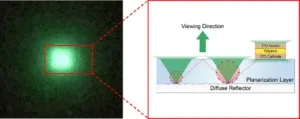One challenge in achieving highly efficient OLEDs is developing means of highly efficient outcoupling. Part of the reason that this has proved difficult is that the desired means needs to be independent of wavelength, independent of viewing angle and not be overly disruptive to the structure of the device. Previous work at the University of Michigan (Ann Arbor, Michigan) to address this issue used a microlens based approach. This work was reported in a Meko subscription newsletter article entitled “Improving the Extraction of Light from OLED’s.” Now, a team of researchers headed by Jongchan Kim within the Department of Electrical Engineering and Computer Science also at the University of Michigan is developing an alternative and improved means of OLED light outcoupling based on the use of a dielectric diffuse reflector.
A recent article on this subject by the team is entitled “Efficient Outcoupling of Organic Light-Emitting Devices Using a Light-Scattering Dielectric Layer.” A copy of the article is available for purchase here.
In this study, the researchers “replaced the conventional bottom metal electrode in top emitting OLEDs with a transparent layer of indium tin oxide deposited on a 240μm thick polytetrafluoroethylene (PTFE, Teflon) diffuse reflector (itself backed by a 20μm thick Al mirror). A planarized high index of refraction (nP = 1.8) polymer slab waveguide covers the rough reflector so as to create a smooth surface on which to fabricate the OLED, while helping maximize the light coupled into the diffuser.”
The structure and light emission characteristics of a prototype OLED device are presented in the figure below.
A phosphorescent OLED stacked on top of a diffuse reflector. Light in the emission cone is scattered into the viewing direction. (Shown in green.) Light that is scattered back into the viewing direction follows a Lambertian profile. (Shown in red).
Paraphrasing the technical article, light exits the OLED in one of two ways. First, it can be emitted directly from the top surface in the viewing direction. This is shown as the green cone in the figure. Second, it can enter the waveguide layer where it propagates until it is scattered by the rough reflector surface into a Lambertian profile. The light within the emission cone then exits into the viewing direction. This is shown in red in the figure. If the light is incident at an angle greater than that for total internal reflection at the polymer – air interface, it is returned to the diffuse reflector and subject to another round of scattering.
The new approach was demonstrated to increase the external quantum efficiency from 15 ± 2% to 37 ± 4% compared to a similar device with a metal mirror.
Based on simulations, the researchers believe that this outcoupling structure could be further optimized to yield a 3.4 fold light extraction improvement over the use of a conventional metal mirror.
The authors conclude by emphasizing the point that this increase in yield can be accomplished without the need for additional outcoupling structures or index matching layers. It follows that this means to increase outcoupling efficiency is potentially suitable for low cost, solid state lighting. -Arthur Berman

